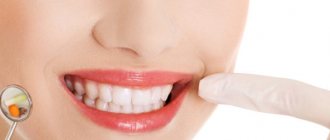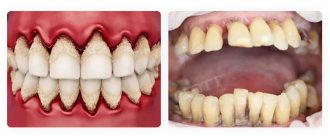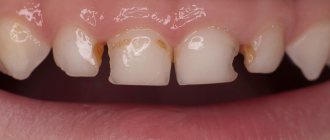Teeth are destroyed not only under the influence of acid-producing bacteria, but also due to traumatic external influences. In both cases, one or more of its roots remain in the gum as a memory of the destroyed tooth. One of the fundamental principles of modern dentistry is the use of tooth-preserving techniques.
Therefore, dentists literally fight for every affected tooth. But if the crown is completely destroyed, and treatment of the roots and restoration of the tooth with a composite or inlay is no longer possible, the doctor will definitely recommend removing the roots and resorting to implantation - the most effective prosthetic method to date.
Unfortunately, only some patients make an appointment with a dentist to find out how to restore the integrity of their dentition. The rest, not experiencing any discomfort for the time being, are in no hurry to get an appointment at the clinic.
When is it necessary to remove a tooth root?
In all cases, the doctor decides individually whether the situation requires tooth root removal after carrying out diagnostic measures and examination using radiography or visiography. Among the most common indications for tooth root removal are the following:
- the patient suffers from aching and throbbing pain in the tooth;
- in the peri-root area there is some swelling of the gums;
- there are signs of inflammation;
- the root of the tooth is destroyed;
- third degree of tooth root mobility;
- tooth fracture is of increased complexity;
- the level at which the destruction of the dental crown is located is located below the level of the gums;
- a cyst was diagnosed.
If the rotting tooth root is not removed in a timely manner, it can give rise to a serious infectious process in the oral cavity, as well as bad breath. Problems will certainly affect healthy tissues nearby.
In some cases, even in the presence of inflammation and severe tooth decay, you can do without root removal. This will allow, after carrying out the necessary therapeutic measures, to restore or build up the tooth. The final decision on this issue is made by the dentist.
Indications for surgery
Today, dentists prefer tooth-preserving operations. Therefore, even if there is only one root left, they first study whether it can be used as a basis for future prosthetics. However, in medical practice there are often situations when the removal of a decayed tooth must be carried out without fail.
This is possible if:
the tooth base has become very loose due to advanced periodontitis;- fracture diagnosed;
- a cyst has been discovered that cannot be removed in isolation;
- a fragment of the crown that extends deep under the gum has broken off;
- a part remained after the unit was carelessly removed.
Milk units should ideally fall out on their own. They are pulled out when the coronal part is completely damaged by caries, loosened or fractured, or a carious process that has spread under the gum.
Tooth root removal: painful or not?
Most often, the situation in which tooth root removal is indicated occurs when the pulp is dead. To avoid pain and discomfort, the “Optimal Choice” dental clinics use modern high-quality local anesthesia before tooth root removal and other manipulations. Therefore, you should not be afraid of pain and put off visiting the dentist for the indefinite future. Today the procedure takes place with a minimum of discomfort.
Consequences
If the root and part of the tooth are left inside the gum tissue, some complications may occur. Inflammation in the pulp chamber can begin as a result of dirt and infection; this process is accompanied by severe pain, the appearance of purulent discharge, rotting, etc. To avoid sepsis, surgical removal of the root and nerve endings is recommended.
Another dangerous disease is periodontitis. In the absence of timely treatment, the unit can become very loose; it is surrounded by voids where germs, food particles, and infection can get in. In this case, the root moves away from the coronal part quite quickly and it becomes almost impossible to save it. If the problem is not corrected in time, there is a high risk of damage to other organs and even blood poisoning. The latter threatens with very serious complications and is dangerous to human health.
Another common occurrence is when a previously filled tooth breaks and particles of the composite get into the hole. These particles can react with tissues, which leads to the development of inflammation. In this case, not only the root of our broken tooth can become inflamed, but also nearby units. If inflammation is left unattended by a specialist for a long period of time, a cyst may appear.
Types of deletion
To remove a tooth root, your dentist may use one of the following methods:
- tongs;
- using an elevator;
- using a drill.
Tooth root removal using forceps is most often used. For the upper roots, tools with straight ends are best, and for the lower roots, beak-shaped models are best. Bayonet pliers are universal and are suitable for all cases. If the tooth is single-rooted, then the rotation method, that is, rotation, is suitable for root removal. If a tooth has several roots, luxation is required.
If the roots are located far away, it may not be possible to remove them with forceps. Then various elevators are used, which operate on a principle similar to levers. The root is twisted out using this tool, and part of it appears on the surface. After this, it is already possible to remove it using forceps. Elevators come in corner and bayonet types. The former give good results on the roots of the lower teeth and their remains, while the latter are often used to remove “figure eights”.
If there are some peculiarities in the location of the roots or their strong “ingrowth” into the bone, the dentist will need a drill. The procedure can take quite a long time and requires high professionalism, however, like all types of medical care. Depending on the severity of the problem, removal surgery may be performed using one of the following methods:
- root hemisection—one of the roots of the tooth is removed;
- root extraction - it is completely removed.
How to pull out the remaining root in the gum
It is always easier for a dental surgeon to remove the entire tooth than just the remaining root parts.
First, the doctor carries out diagnostic measures, which include:
inspection;- reorganization;
- taking pictures.
If he deems it necessary, he may ask the client to take a blood test. On the appointed day, the patient is given an anesthetic. Local anesthesia is usually sufficient. When the anesthetic takes effect, the hard fragments are removed using special forceps. When the gums are completely overgrown, they are first excised, and the bone tissue is drilled out to gain access to the root zone. After this, using a dental elevator, all detected particles of the missing unit are removed. Such an operation is certainly complex and traumatic. Upon completion, stitches are applied.
Stages of the procedure
First, the dentist must conduct a diagnostic examination, examining the root of the tooth and the patient’s oral cavity. Particular attention is paid to the condition of the gums and the presence of inflammation. A survey and medical history allows you to choose the best method of anesthesia that will not cause an allergic reaction.
Then the doctor, based on the condition of the tooth root, selects the extraction method and prepares the instrument to be used.
An injection with an anesthetic is made into the gum in the area of the affected tooth root, and further procedures to remove the root using the chosen method are carried out after the anesthesia has taken effect.
After the tooth root is removed, the oral cavity is treated with an antiseptic, then an anti-inflammatory agent is applied to the treated area. If an incision was made in the gums, it is necessary to apply sutures. They are removed after a week. After tooth root removal, the patient is prescribed analgesics and antibiotics.
Amputation of a part
It is not always necessary to remove the entire root. In certain situations, the doctor may decide to perform an amputation. This operation involves removing only part of the hard tissue located deep in the gum. Their healthy fragments remain intact. The space that remains after removing the elements is filled with a special osteoplastic mass. Due to this, the unit continues to be securely held in the dentition and hardly becomes loose. Amputation is only relevant if the crown is in satisfactory condition. If it is absent, there is no point in such treatment, since a partially preserved root cannot be considered as a durable support for a prosthesis or bridge.
Possible complications
Among the most common complications that occur during tooth root removal are the following:
- dislocation of the jaw, if the doctor has little experience;
- inflammatory process in the hole;
- penetration of bone particles into it;
- damage to teeth located next to the one being removed;
- allergy to anesthesia;
- heavy bleeding.
If you do not skimp on dental services and contact an experienced specialist, as well as follow all medical recommendations, then the risk of complications is minimized.
If there are root fragments left in the hole
If the wound edges were tightened with catgut, the patient’s treatment can be considered complete. If a non-absorbable material was used, the patient will have to return to the dentist to have the sutures removed after a week. During this time, it is necessary to monitor the condition of the gums, your own sensations and notify the doctor if:
the operated areas constantly hurt;- throbbing pain is felt.
This means that small fragments of tooth tissue, which may have gone unnoticed during extraction, rot in the hole. The doctor must prescribe a repeat X-ray for the patient, check the quality of the operation and find out the cause of the ailment. Inaction is fraught with the development of alveolitis (inflammation of the socket), osteomyelitis, phlegmon and other serious diseases.
Preventive actions
The main prevention of possible complications after tooth root removal is the patient’s compliance with all recommendations given by the dentist. These include:
- after the operation, you need to press the gauze swab tightly against the hole for 15-20 minutes and then remove it;
- During the day, it is necessary to treat the fresh wound very carefully so as not to disturb the formed clot. For example, you will have to give up mechanical teeth cleaning;
- for five hours after surgical removal of the tooth root, you should stop drinking hot foods and eating;
To avoid inflammation, you should contact your dentist again at the slightest suspicion.
Large tooth surface
One of the most common situations is the presence of root fragments after extraction of wisdom teeth. This is explained by the fact that the procedure for removing eights in itself is very difficult due to the range of location of these units. In addition, a wisdom tooth usually has a rather massive root system and the crown part itself, so even an experienced technician cannot always cope with its extraction.
Even when removing chewing teeth, if there are certain anatomical problems in the oral cavity, complications may arise. Such teeth are quite difficult to visualize, so access to them is difficult.
Another possible scenario for the development of events during tooth extraction: the presence of a second affected unit nearby. When a tooth is removed, a fragment of a nearby tooth may accidentally fall into the resulting hole. There may be several reasons for this, for example, too much pressure from the instrument during crown surgery.
Experts' opinion
Question: After removing the root, the doctor told me to rinse my mouth. What means can be used for this?
Answer : Among the most accessible means for rinsing the mouth after tooth root removal are: a weak salt solution (you can use a mixture of salt and baking soda in equal proportions), miramistin, chlorhexidine, a weak solution of potassium permanganate (light pink), a decoction or infusion of medicinal products herbs (chamomile, sage, eucalyptus, calendula). Oak bark helps very well. It must be remembered that active rinsing cannot be carried out on the first day after surgery. During this period, you just need to put the product in your mouth and hold it for a few minutes, then spit it out.
Question: Is it possible to remove a tooth root yourself at home?
Answer : Doctors at the Optimal Choice dental clinics recommend that you never try to remove a tooth root at home on your own, but if you have the slightest problem with your teeth, visit a dentist as soon as possible. It is not worth saving on your health, since such savings may entail large expenses in the future. At home, it is not possible to painlessly, efficiently and correctly remove the root of a tooth using improvised means. This can only be done in a clinical setting.
What to do
Of course, you shouldn’t sit and wait for the pain and discomfort in the area of a tooth overgrown with gums to go away on its own. It is best to immediately contact a specialized dental clinic for medical advice. Only he will be able to conduct a comprehensive examination of the oral cavity, prescribe the necessary tests, conduct an X-ray examination and prescribe the correct treatment.
As a rule, a broken tooth that is overgrown with soft tissue is carefully removed. This requires making an incision in the gum. If the tooth is healthy, then after opening the hole the doctor can install an artificial root and prosthesis into it.
If it is not possible to save the tooth, then a procedure is performed to extract its root system. To do this, the specialist uses a special tool called an elevator, with which he cuts the top of the unit and gradually brings it to the surface. Such manipulations are carried out under local anesthesia and do not take much time. After extraction of a diseased tooth, a medicinal drug can be applied to the wound, which promotes faster healing. The stitches are removed after a few weeks.
What are the dangers of rotten teeth, consequences for the body
Many people ignore the process of tooth decay unless it is accompanied by severe pain. But the consequences of the carious process can be unpredictable and dangerous. If you have rotten teeth, the following complications may develop:
- Destruction of bone tissue of the musculoskeletal system.
- Endocarditis is inflammation of the lining of the heart.
- Inflammatory pathologies of the kidneys.
- Infections of ENT organs.
- Psychological complexes due to discomfort during communication and dissatisfaction with the appearance of the dentition.
- Purulent-inflammatory diseases in the gums (abscesses, phlegmons) and, as a result, the spread of infection throughout the body, leading to general intoxication.
The health of baby teeth greatly affects the condition of the permanent buds. Therefore, if nothing is done about the decay of milk dental tissues, in the future the child may have big problems with the formation of a permanent dentition.
What symptoms occur?
The main symptom is the presence of pain. At first they are aching in nature, so many patients do not attach any importance to this. Over time, discomfort cannot be relieved even with the help of powerful painkillers. If you do not immediately visit a doctor and take action, on the third day swelling of the mucous membrane occurs, possibly even an increase in body temperature.
Next comes the most unpleasant moment - the putrefactive process. A bad odor appears from the mouth, and a white coating is noticeable around the hole. It doesn’t come to this very often, since severe pain in most cases provokes a person to go to the dentist again.
What to do if your teeth are rotting
Rot inside the tooth is dangerous for the entire body. Therefore, at the first signs of decay of dental tissues, you should go to the dentist.
Before providing first aid, it is recommended:
- Rinse your mouth with a herbal decoction that has anti-inflammatory and antimicrobial effects. It's better to take chamomile and sage.
- Rinse your mouth with a pharmaceutical antiseptic: Chlorhexidine, Miramistin.
- Thoroughly clean the surface of the dentition to prevent the accumulation of soft plaque and its transformation into hard tartar: bacteria multiply under its surface and spoil the enamel even faster.
- You should not try to remove pus yourself by picking at the enamel with a sharp object. This action will provoke even greater destruction of damaged tissue.
- On the side of the jaw where the rotten tooth is located, it is better not to chew anything so that food does not penetrate into the carious holes.
- After eating, you need to rinse the remaining pieces of food with a weak saline solution or boiled water.










